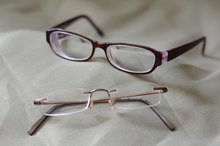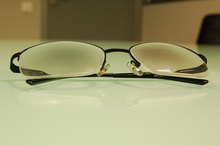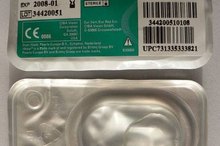Bifocals began when Benjamin Franklin had the lenses of two different spectacles cut in half and wired into a single frame. As technology has advanced, more complex lens configurations were created, with multiple areas of magnification, called segments, cut into the same lens. Today a variety of lens designs offer a convenient way to improve vision that range from simple to sophisticated 3.
Flat-Top Lenses
Also known as the "D" style mutli-focal lens, this type of lens has an a magnifying area in the lower part of the lens that resembles a letter D turned on its side, with the flat side up. This is among the easiest of multi-focal lenses to adapt to. It is also an available lens design and can be produced in any lens material. The flat top of the lens provides a definite transition between reading and distance vision 3.
- Also known as the "D" style mutli-focal lens, this type of lens has an a magnifying area in the lower part of the lens that resembles a letter D turned on its side, with the flat side up.
Kryptok Lenses
How to Compare Varilux and Shamir Progressive Lenses
Learn More
Also referred to as a round lens, the magnifying area in the lower part of the lens is a complete circle. The lens can restrict viewing up top, due to the round shape. There is less significant transition between reading and distance vision 3.
Curved Top Lenses
Also known as the C-style, the magnification area is similar to the "D" style lens. However, the top of the area is slightly curved upward. The rounded corners on the segment are often marketed as enhancing peripheral vision 3.
Franklin Lenses
What Are Lenticular Eyeglass Lenses?
Learn More
This lens most closely resembles the original bifocal lenses invented by Benjamin Franklin and are also known as executive, dual and full-segment lenses.
This lens is often used as an occupational lens for those who do a lot of reading. Because the magnification area is so large, this style of lens offers the widest reading range of any bifocal.
Ultex Lenses
The ultex lens, also called the baseball segment, is similar to the executive lens, but with a curved rather than a straight transition. The wide segment makes ultex lenses an excellent choice for an occupational lens that offers a wider reading range.
Blended Lenses
Blended bifocal lenses are also referred to as the invisible or seamless bifocal. This lens is designed to conceal the transition from the magnification segment to the distance segment. This is accomplished by placing a blended range of 1mm to 2mm between the segments. This range can distort perspective at times that some may not adapt to easily.
- Blended bifocal lenses are also referred to as the invisible or seamless bifocal.
- This lens is designed to conceal the transition from the magnification segment to the distance segment.
Vocational Lenses
Vocational lenses have multiple magnifying segments in each lens above and below the midline of the lens. Double D, double Franklin and double-circle lenses are common configurations.
Trifocal Lenses
Trifocals incorporate three different focal lengths, the primary prescription and the top and bottom halves of the segment, each at different magnifications.
Specialty Lenses
Specialty lenses can combine the benefits of different lens configurations to best improve the vision of the user 3.
Computer Lenses
These lenses separate the magnification powers into three progressive fields. Intermediate viewing is at the top of the lens, while near vision is at the bottom, with distance in the middle 3. This lens can help reduce the stress experienced when viewing computer monitors for long periods of time.
Progressive Lenses
Progressive lenses are true multi-focal lenses that more closely mimic the natural vision 3. The top portion of the lens is for distance vision 3. The center of the lens provides intermediate viewing, and the bottom allows for close reading. The transitions from one segment to another are smooth and seamless.
Related Articles
References
- World Optic
- All about Vision
- Hejtmancik JF, Shiels A. Overview of the lens. Prog Mol Biol Transl Sci. 2015;134:119-127. doi:10.1016/bs.pmbts.2015.04.006
- Aliancy J, Mamalis N. Webvision: The organization of the retina and visual system. University of Utah. 2020.
- American Academy of Opthalmology. Normal crystalline lens. 2020.
- Centers for Disease Control and Prevention. Facts about Anophthalmia/Microphthalmia. 2019.
- Birth Defect Research for Children. Congenital cataracts. (n.d.)
- Turbert D. Eye exam and vision testing basics. American Academy of Ophthalmology. Updated August 14, 2020.
Writer Bio
In Jacksonville, Fla., Frank Whittemore is a content strategist with over a decade of experience as a hospital corpsman in the U.S. Navy and a licensed paramedic. He has over 15 years experience writing for several Fortune 500 companies. Whittemore writes on topics in medicine, nature, science, technology, the arts, cuisine, travel and sports.









